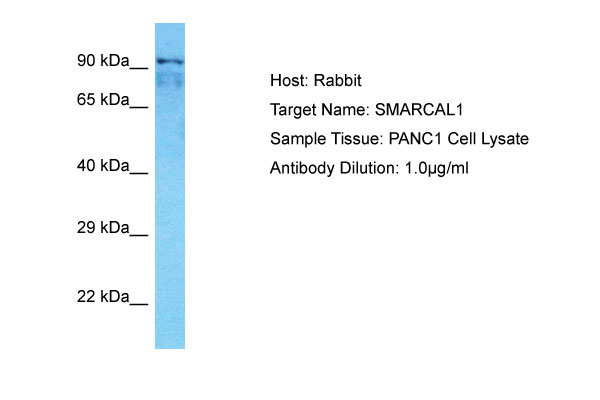SMARCAL1 Antibody - N-terminal region
Rabbit Polyclonal Antibody
- SPECIFICATION
- CITATIONS
- PROTOCOLS
- BACKGROUND

Application
| WB |
|---|---|
| Primary Accession | Q9NZC9 |
| Other Accession | XP_005246689 |
| Reactivity | Human |
| Predicted | Human |
| Host | Rabbit |
| Clonality | Polyclonal |
| Calculated MW | 104kDa |
| Gene ID | 50485 |
|---|---|
| Alias Symbol | SMARCAL1, HARP, |
| Other Names | SWI/SNF-related matrix-associated actin-dependent regulator of chromatin subfamily A-like protein 1, 3.6.4.-, HepA-related protein, hHARP, Sucrose nonfermenting protein 2-like 1, SMARCAL1, HARP |
| Format | Liquid. Purified antibody supplied in 1x PBS buffer with 0.09% (w/v) sodium azide and 2% sucrose. |
| Reconstitution & Storage | Add 50 &mu, l of distilled water. Final Anti-SMARCAL1 antibody concentration is 1 mg/ml in PBS buffer with 2% sucrose. For longer periods of storage, store at -20°C. Avoid repeat freeze-thaw cycles. |
| Precautions | SMARCAL1 Antibody - N-terminal region is for research use only and not for use in diagnostic or therapeutic procedures. |
| Name | SMARCAL1 (HGNC:11102) |
|---|---|
| Function | ATP-dependent annealing helicase that binds selectively to fork DNA relative to ssDNA or dsDNA and catalyzes the rewinding of the stably unwound DNA. Rewinds single-stranded DNA bubbles that are stably bound by replication protein A (RPA). Acts throughout the genome to reanneal stably unwound DNA, performing the opposite reaction of many enzymes, such as helicases and polymerases, that unwind DNA. May play an important role in DNA damage response by acting at stalled replication forks. |
| Cellular Location | Nucleus Note=Recruited to damaged DNA regions |
| Tissue Location | Ubiquitously expressed, with high levels in testis. |

Thousands of laboratories across the world have published research that depended on the performance of antibodies from Abcepta to advance their research. Check out links to articles that cite our products in major peer-reviewed journals, organized by research category.
info@abcepta.com, and receive a free "I Love Antibodies" mug.
Provided below are standard protocols that you may find useful for product applications.
Background
ATP-dependent annealing helicase that binds selectively to fork DNA relative to ssDNA or dsDNA and catalyzes the rewinding of the stably unwound DNA. Rewinds single-stranded DNA bubbles that are stably bound by replication protein A (RPA). Acts throughout the genome to reanneal stably unwound DNA, performing the opposite reaction of many enzymes, such as helicases and polymerases, that unwind DNA. May play an important role in DNA damage response by acting at stalled replication forks.
References
Coleman M.A.,et al.Genomics 65:274-282(2000).
Boerkoel C.F.,et al.Nat. Genet. 30:215-220(2002).
Hillier L.W.,et al.Nature 434:724-731(2005).
Mural R.J.,et al.Submitted (JUL-2005) to the EMBL/GenBank/DDBJ databases.
Bechtel S.,et al.BMC Genomics 8:399-399(2007).
If you have used an Abcepta product and would like to share how it has performed, please click on the "Submit Review" button and provide the requested information. Our staff will examine and post your review and contact you if needed.
If you have any additional inquiries please email technical services at tech@abcepta.com.













 Foundational characteristics of cancer include proliferation, angiogenesis, migration, evasion of apoptosis, and cellular immortality. Find key markers for these cellular processes and antibodies to detect them.
Foundational characteristics of cancer include proliferation, angiogenesis, migration, evasion of apoptosis, and cellular immortality. Find key markers for these cellular processes and antibodies to detect them. The SUMOplot™ Analysis Program predicts and scores sumoylation sites in your protein. SUMOylation is a post-translational modification involved in various cellular processes, such as nuclear-cytosolic transport, transcriptional regulation, apoptosis, protein stability, response to stress, and progression through the cell cycle.
The SUMOplot™ Analysis Program predicts and scores sumoylation sites in your protein. SUMOylation is a post-translational modification involved in various cellular processes, such as nuclear-cytosolic transport, transcriptional regulation, apoptosis, protein stability, response to stress, and progression through the cell cycle. The Autophagy Receptor Motif Plotter predicts and scores autophagy receptor binding sites in your protein. Identifying proteins connected to this pathway is critical to understanding the role of autophagy in physiological as well as pathological processes such as development, differentiation, neurodegenerative diseases, stress, infection, and cancer.
The Autophagy Receptor Motif Plotter predicts and scores autophagy receptor binding sites in your protein. Identifying proteins connected to this pathway is critical to understanding the role of autophagy in physiological as well as pathological processes such as development, differentiation, neurodegenerative diseases, stress, infection, and cancer.


